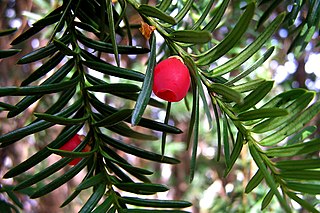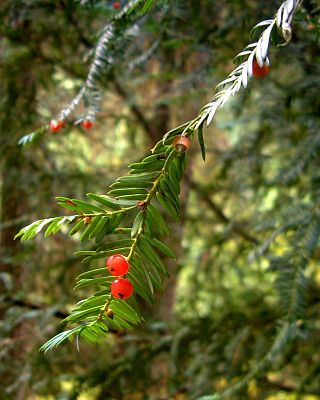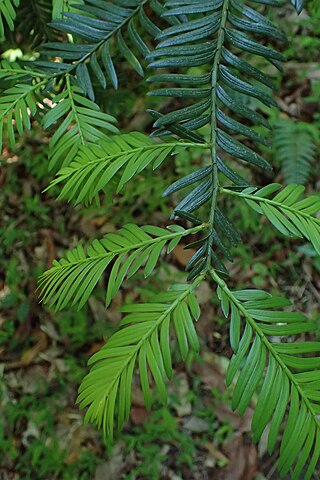
Paclitaxel, sold under the brand name Taxol among others, is a chemotherapy medication used to treat ovarian cancer, esophageal cancer, breast cancer, lung cancer, Kaposi's sarcoma, cervical cancer, and pancreatic cancer. It is administered by intravenous injection. There is also an albumin-bound formulation.

Taxus is a genus of coniferous trees or shrubs known as yews in the family Taxaceae. Yews occur around the globe in temperate zones of the northern hemisphere, northernmost in Norway and southernmost in the South Celebes. Some populations exist in tropical highlands.

Taxaceae, commonly called the yew family, is a coniferous family which includes six extant and two extinct genera, and about 30 species of plants, or in older interpretations three genera and 7 to 12 species.
As distinct from the Western medical concept of urinary bladder, this concept from traditional Chinese medicine is more a way of describing a set of interrelated functions than an anatomical organ.

Alpinia zerumbet, commonly known as shell ginger among other names, is a perennial species of ginger native to East Asia. The plants can grow up to 2.5 to 3 meters tall and bear colorful funnel-shaped flowers. They are grown as ornamentals and their leaves are used in cuisine and traditional medicine.

Taxus brevifolia, the Pacific yew or western yew, is a species of tree in the yew family Taxaceae native to the Pacific Northwest of North America. It is a small evergreen conifer, thriving in moisture and otherwise tending to take the form of a shrub.

Senna obtusifolia, known by the common names Chinese senna, American sicklepod, sicklepod, etc., is a plant in the genus Senna, sometimes separated in the monotypic genus Diallobus. It grows wild in North, Central, and South America, Asia, Africa, and Oceania, and is considered a particularly serious weed in many places. It has a long-standing history of confusion with Senna tora and that taxon in many sources actually refers to the present species.

Paclitaxel total synthesis in organic chemistry is a major ongoing research effort in the total synthesis of paclitaxel (Taxol). This diterpenoid is an important drug in the treatment of cancer but, also expensive because the compound is harvested from a scarce resource, namely the Pacific yew. Not only is the synthetic reproduction of the compound itself of great commercial and scientific importance, but it also opens the way to paclitaxel derivatives not found in nature but with greater potential.

Taxus wallichiana, the Himalayan yew, is a species of yew, native to the Himalaya and parts of south-east Asia. The species has a variety of uses in traditional medicine. It is currently classified as endangered by the IUCN.

Aglaia odorata is a species of plant in the family Meliaceae. It is found in Cambodia, China, Indonesia, Myanmar, Taiwan, Thailand, Vietnam, and possibly Laos.

Platostoma palustre, commonly known as Chinese mesona, is a species of plant belonging to the genus Platostoma of the mint family. The species grows extensively in East Asia such as south east China, Japan and Taiwan preferring ravines, grassy, dry, and sandy areas. The plants are from 15 to 100 cm high with hairy stems and leaves. The leaves are tear-drop shaped and serrated.

Taxifolin (5,7,3',4'-flavan-on-ol), also known as dihydroquercetin, belongs to the subclass flavanonols in the flavonoids, which in turn is a class of polyphenols. It is extracted from plants such as Siberian larch and milk thistle.

Sphagneticola calendulacea is a perennial herb in the genus Sphagneticola. It is found in China, India, Indonesia, Japan, Myanmar, Philippines, Sri Lanka, Thailand, Taiwan and Vietnam. Tolerant to drought, humidity and barren environment, S. calendulacea is a common herbaceous plant in China and Taiwan. S. calendulacea produces wedelolactone and demethylwedelolactone.
Emperor Cảnh Thịnh, born Nguyễn Quang Toản, was the third and last emperor of the Tây Sơn dynasty. He followed his father Quang Trung at the age of 9, and reigned for 10 years.
Nông Thị Xuân (1932–1957) was a mistress of Viet Minh leader Ho Chi Minh, who mothered a child with Hồ and died in a vehicle accident shortly after Xuân was an ethnic Nùng from Cao Bằng Province.
Trichoderma paucisporum is a species of endophytic fungus in the family Hypocreaceae. It was first isolated in Ecuador from cacao pods infected with frosty pod rot, Moniliophthora roreri. It produces a volatile antibiotic that inhibits development of M. roreri.

Hibiscus taiwanensis, or the Taiwan cotton rose, is a native plant in Taiwan, which lives in China and low altitude in Taiwan. It is a species of plant in the Malvaceae family. The form of flower is different from Hibiscus mutabilis in China, which is double. It can attract butterflies.
Zanthoxylum macranthum , is a species of woody plants in the family Rutaceae. It is native to the upland open forests and thickets in south-east Tibet and southern China, and has been found in Chongqing (Nanchuan), Guizhou, south-west Henan, western Hubei, Hunan, Sichuan, southern Yunnan (Xishuangbanna), and south-east Xizang.

Taxus mairei, Maire's yew, is a species of conifer in the yew family Taxaceae, native to Nepal, Assam, central and southern China, Hainan, Taiwan and Vietnam. It is extensively harvested for its paclitaxel (taxol) content in China.
Crotalaria similis, also known as the Pingtung Curara pea, belongs to the family Fabaceae and genus Crotalaria. It is a perennial crawling herb, an endemic species of Taiwan which the distribution is limited to the Eastern seaside of the Hengchun Peninsula.















